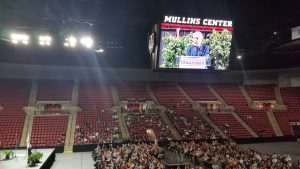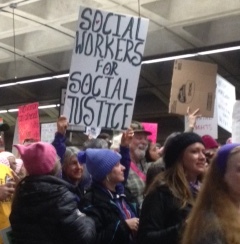Teaching on an active campus with lots of public lectures and events allows for opportunity to enhance our courses. Yet opportunities can come with some unintended costs. When we see the schedule come out for upcoming events of the new semester it is tempting to pack our classes with them. Typical approaches send students to these lectures as extra credit assignments and some “require” that students attend on their own time. Often students have to write some sort of reflection piece to show they attended the talk. Sometimes the course schedule may align, or partially overlap, with the time of the lecture, yet at most institutes of higher learning schedule alignment seems to occur once in a blue moon.
As teachers we know the magic of students exploring new topics that ignite a new passion. We know that speakers can be inspiring and can lead students to pursue new avenues of research or to investigate a brand new subject matter that we did not have the expertise to address in class—especially true in the interdisciplinary world of human rights. We ourselves have been inspired, why not them? However, in human rights, and many other fields for that matter, sending students to public lectures unprepared can lead to headaches for all involved.

In my time teaching at public universities and private colleges I have tried a few different approaches to utilizing public lectures/events happening around campus. Some have been more successful than others. At first I would follow the approach I was most familiar with: sending students to public lectures for extra credit and having them write up a “reflection.” This worked okay but I found only a certain subset of the students would pursue it: (A) Students who wanted to boost their grade (and usually not the ones who REALLY needed that boost) and (B) students interested in the topic with the time to attend who would likely be going to the lecture regardless. Furthermore, this approach ranked out some students from attending, namely those with less schedule flexibility that often work and/or have caregiving responsibilities. Overall, to me it felt that this approach proved a little hit or miss for influencing how many students would actually attend and our resulting discussion about the lecture in class was often disjointed for the full class. In attempts to remedy this I have brought full classes to public events, as well as brought in guest speakers to my class when they were on campus for an event. These latter two approaches I felt were more effective yet also come with pitfalls of which to be wary.
Here are some tips that I’ve gleaned from my experience with public lectures/events and listening to student responses after attending them:
(1) Prepare students as much as is feasible for the upcoming content. Students like to have warning about what the talk is going to be about and if possible go over some of the jargon the speaker is likely to use beforehand. Of course, that is difficult to predict, but a good faith effort goes a long way and sometimes really pays off as students tend to pickup on more than they would have otherwise, especially key if the speaker will be visiting your class.
(2) Be careful about sending them to a lecture pitched at too high a level (especially for international students who may have difficulty with the English language). I have certainly made the mistake of sending my class composed of many international students to some events that were clearly pitched at a niche audience, a deadening event for all involved.
(3) Consider interactive events rather than only formal lectures. With research now displaying that college age student attention spans for dense topics withering after 10-15 minutes of lecture (Burke & Ray 2008)[1] sometimes other events beyond the typical 50-minute lecture may add real value. For instance, I oriented and scheduled my class this semester around a human rights film series, which included some initial remarks, a film screening, and an ending discussion with Q & A, which kept the flow of the event moving. There are many opportunities around campus for more non-traditional and interactive events. Be on the lookout for events such as job fairs, student organization events, concerts, poetry readings, political protests, and field trips if possible. All of which would get them outside the classroom, interacting with people, and then reporting back about their experience. My guess is years later they will remember effective interactive, outside of class events involving experiential learning, more than many topics taught in our classroom (sorry “sage on a stage” model). Feel free to check out previous posts on this blog that discussed the power of experiential learning approaches including trips down the US Eastern Seaboard during election week and exploring advocacy in D.C.
(4) Don’t overburden them. We are well aware that students’ time is under threat from all sides. If many of your students work or have other outside responsibilities, such as caretaking, be aware of that when scheduling. I have made the mistake of over scheduling outside events and I could tell the students felt overwhelmed. If you cannot schedule events into your class time and have to go the extra credit route be sure to have multiple events at different times and/or days of the week. A few targeted events, at different times, that are talked up beforehand in class may be better than simply listing many with assumed equal importance.
(5) Lastly, and perhaps most importantly, be sure to describe academic rules of etiquette. Ever been to a lecture where half the student audience leaves when the speaker is about to field questions? Of course reminders about appropriate tech usage and what is expected in terms of format helps and will make your students feel more comfortable. You never know if this is the first event of this type they have attended in college.
Don’t forget to have fun with lectures/events and do not lose sight of the magic that can happen through them. One may never know what will ignite students’ passion, but as teachers we can do our best to give them as much grounded electricity as we can. In other words, minimize short circuits!
Feel free to comment here on your experience incorporating lectures and events into your courses—I am sure there are many creative approaches out there! We would love to hear about your experience.
References: [1] Burke, L.A., Ray, R. (2008). Re-setting the concentration levels of students in higher education: an exploratory study. Teaching in Higher Ed. 13(5), 571–582.
Author: Jack J. Barry, Ph.D. University of Connecticut.


